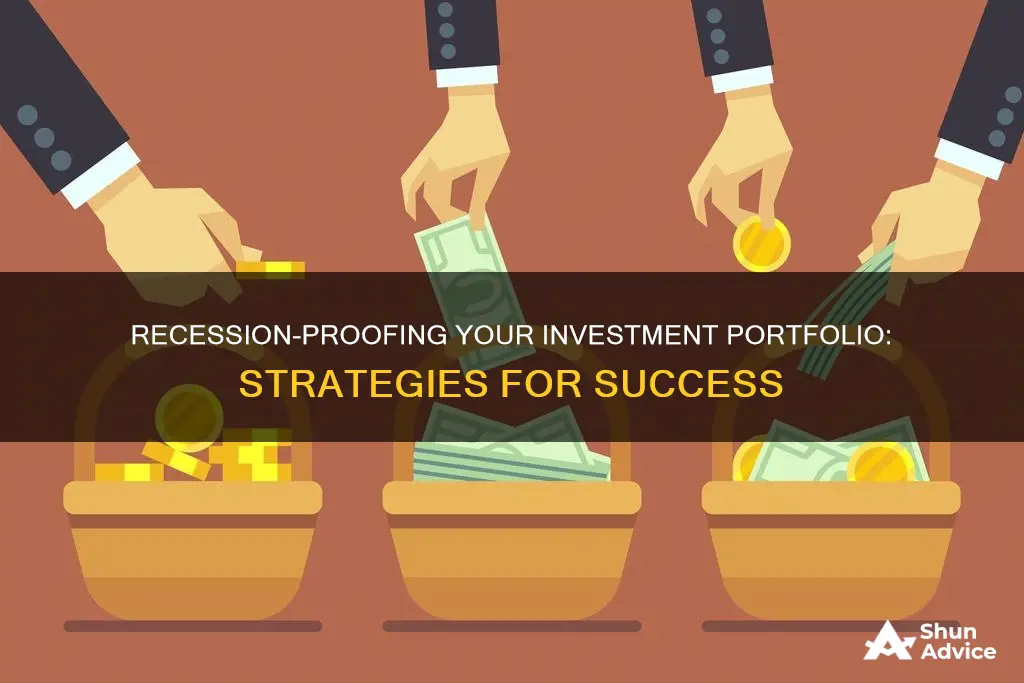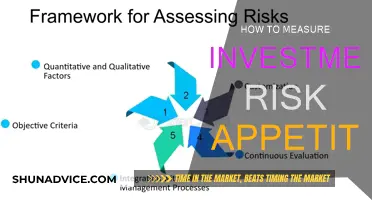
With the ever-looming threat of a recession, it is important to know how to protect your investment portfolio. While it is impossible to predict exactly when a recession will occur, there are steps you can take to ensure your investments are as secure as possible. Diversification is key, and investors should aim to have a variety of investments and assets in their portfolio, including shares, bonds, cash, gold, commodities, and cryptocurrency. It is also important to be aware of the correlation ratios between your investments, to ensure they do not all suffer in a downturn. In addition to diversifying, individuals should also focus on their income, ensuring they live within their means, have an emergency fund, and have multiple sources of income.
What You'll Learn

Diversify your portfolio
Diversifying your portfolio is a crucial step in recession-proofing your investments. The key is to ensure you have a mix of investments and assets that will not all be affected by an economic downturn. Here are some detailed strategies to achieve true diversification:
Understand Correlation Ratios
Correlation ratios measure how different assets move in relation to each other. A ratio of +1 indicates a perfect positive correlation, meaning two assets move in the same direction. A ratio of -1 means they are synced and correlated negatively, so when one goes up, the other goes down. A ratio of 0 indicates no correlation, where one asset's movement does not predict the other's. To achieve diversification, aim for a mix of assets with varied correlation ratios.
Aim for a Variety of Investments
Instead of putting all your eggs in one basket, diversify across different types of investments and asset classes. Aim for at least seven to ten types of investments, including stocks, bonds, cash, real estate, private equity, promissory notes, debt investments, cryptocurrencies, and precious metals. This way, if one type of investment takes a hit during a recession, you have others to fall back on.
Choose Investments with Low Correlation
Look for investments with low correlation to the stock market or those that move in opposition to it. For example, during a recession, riskier assets like stocks and high-yield bonds tend to lose value, while gold and certain types of bonds may appreciate. Shares of large, established companies with steady cash flows and dividends also tend to outperform riskier stocks.
Consider Consumer Staples
Historically, the consumer staples sector has been a safe bet during recessions. This includes companies that provide essential products like food, beverages, household goods, alcohol, tobacco, and toiletries. People still need these items regardless of the economic climate, so these companies can be more stable investments.
Be Wary of Risky Sectors
On the other hand, be cautious about investing heavily in sectors that tend to suffer during recessions. These include appliance retailers, automakers, and technology suppliers, as consumers and businesses may cut back on discretionary spending.
By following these strategies, you can build a well-diversified portfolio that is better equipped to weather a recession and protect your financial future.
Savings, Investment, and Their Intricate Balance Sheet Equation
You may want to see also

Understand correlation ratios
Correlation ratios are a key concept in investment and portfolio management, especially when it comes to recession-proofing your investments. These ratios help you understand how different investments are related and how they move together or in opposition to each other.
The correlation ratios range from +1 to -1:
- A correlation ratio of +1 indicates a perfect positive correlation between two assets, meaning they move in the same direction. For example, public stocks tend to have a high positive correlation, so when the market is up, most stocks move positively together, and when the market is down, they also tend to move down together.
- On the other hand, a correlation ratio of -1 represents a negative correlation, where two assets move in opposite directions. For instance, when the value of your stocks decreases, an asset with a negative correlation will increase in value, acting as a hedge against losses.
- A correlation ratio of 0 implies zero correlation, where the movement of one asset does not predict the movement of the other.
The problem with public stocks is that they often have a high positive correlation, which can be financially detrimental during a recession as your entire stock portfolio may suffer losses simultaneously. To build a recession-proof portfolio, it is crucial to diversify your investments and include assets with varying correlation ratios.
Ideally, aim for at least seven to ten types of investments and assets, each with different correlation ratios. This can include a mix of private equity, real estate, promissory notes, debt investments, cryptocurrencies, and precious metals. By doing so, you reduce the risk of your entire portfolio suffering during a recession and increase the chances of having assets that perform well during different economic cycles.
Additionally, keep an eye on the correlation between your different investments. While diversification is essential, it's also crucial that your investments are truly diverse and not just different stocks or funds, as these tend to be tightly correlated.
H1B Visa Holder? Smart Investment Strategies for Your Savings
You may want to see also

Invest in alternative assets
Investing in alternative assets is a crucial component of a well-diversified portfolio, especially when aiming to recession-proof your investments. Here are some alternative assets to consider:
Private Equity Investments
Private equity offers access to investing in private companies or businesses that are not publicly traded on stock exchanges. These investments can include venture capital, growth equity, leveraged buyouts, and distressed investments. Private equity investments tend to have longer investment horizons and may provide diversification benefits due to their lower correlation with public markets.
Real Estate
Investing in real estate provides exposure to a tangible asset class. You can invest in physical properties, such as residential or commercial real estate, or explore options like real estate investment trusts (REITs), which are companies that own and operate income-generating real estate. Real estate can offer stable cash flow through rental income and the potential for capital appreciation over time.
Promissory Notes and Debt Investments
Promissory notes are financial instruments representing a promise to repay a debt. They can be issued by individuals, corporations, or other entities. Debt investments, such as bonds, involve lending money to governments, municipalities, or corporations in exchange for periodic interest payments and the return of the principal amount upon maturity. These investments typically offer fixed income streams, which can be attractive during times of economic uncertainty.
Cryptocurrencies
Cryptocurrencies are digital assets that have gained significant popularity as an alternative investment class. They are decentralized, meaning they are not controlled by any central authority, and they offer potential benefits such as enhanced security, faster transactions, and lower fees compared to traditional payment systems. However, it's important to approach cryptocurrencies with caution due to their high volatility and regulatory uncertainty.
Precious Metals
Investing in precious metals, such as gold, silver, or platinum, can serve as a hedge against inflation and economic uncertainty. Historically, the price of gold, in particular, has often moved inversely to the stock market and can provide a store of value during turbulent economic times. Precious metals can be purchased in physical form, such as bullion or coins, or through exchange-traded funds (ETFs) that track the price of these metals.
By incorporating these alternative assets into your investment portfolio, you can enhance diversification, reduce the impact of market downturns, and potentially position yourself to benefit from a range of investment opportunities. Remember to conduct thorough research, assess your risk tolerance, and consult with a financial advisor before making any investment decisions.
Understanding Your Investment Portfolio: A Beginner's Guide
You may want to see also

Have an emergency fund
Having an emergency fund is a crucial part of recession-proofing your investment portfolio. This fund will provide a financial buffer if you encounter any difficulties during a recession, allowing you to avoid panic-selling your investments or taking on debt. Here are some key considerations for building an emergency fund:
Size of the Fund
It is generally recommended that your emergency fund should cover at least three to six months' worth of living expenses. This includes essential payments such as rent or mortgage, utilities, groceries, transportation, and minimum debt payments. If you are the sole breadwinner in your family or have dependents, you may want to consider a larger fund for added security.
Location of the Fund
It is advisable to keep your emergency fund in a high-yield savings account that is insured by the Federal Deposit Insurance Corporation (FDIC). This will ensure that your money is easily accessible when needed and is earning a reasonable rate of interest.
Building the Fund
If you don't already have an emergency fund, start building one as soon as possible. Set a realistic monthly savings goal and automate your savings by setting up regular transfers from your paycheck or other income sources. If you have a windfall, such as a bonus or tax refund, consider allocating a portion of it towards your emergency fund.
Using the Fund
Your emergency fund is intended to cover essential living expenses during a financial setback, such as a job loss or unexpected medical bills. It is important to resist the temptation to use this fund for non-essential purchases. If you need to use the fund, make sure to replenish it as soon as possible to get back to a comfortable level of savings.
Investing the Fund
While the primary purpose of an emergency fund is accessibility and stability, you can also consider investing a portion of it for potential growth. You may choose to invest a small percentage in riskier assets, such as stocks or cryptocurrencies, but be aware of the potential for volatility. It is generally recommended to consult a financial advisor before making any significant changes to your investment strategy.
In summary, having an emergency fund is a crucial component of your financial strategy, especially when recession-proofing your investment portfolio. This fund will provide peace of mind and financial security, allowing you to make more informed and less impulsive decisions during a recession.
Savings-Investment Equilibrium: What's the Balancing Act?
You may want to see also

Be realistic about risk tolerance
Being realistic about your risk tolerance is a crucial aspect of recession-proofing your investment portfolio. Here are some detailed instructions and considerations to help you navigate this topic effectively:
Understanding Risk Tolerance
Risk tolerance refers to the amount of risk you are comfortable taking on in your investment decisions. It is essential to be realistic and honest with yourself about how much risk you can handle. While investing, it's common to encounter fluctuations and uncertainties, and your risk tolerance determines how you respond to these situations.
Age and Risk
It's important to consider your age when assessing your risk tolerance. Younger investors are generally advised to take on more risk as they have a longer time horizon for their investments to recover from any potential losses. However, as you approach retirement age, it's prudent to shift towards more conservative investments to protect your savings.
Emotional Response to Risk
Risk tolerance is not just about the numbers; it's also about your emotional response to market volatility. If you find yourself losing sleep or feeling anxious when your investments decline in value, it's an indication that you may need to reevaluate your risk tolerance. Investments should provide a sense of financial security rather than constant worry.
Adjusting Your Portfolio
If you realize that your current level of risk is too high, don't make hasty decisions. Avoid selling your investments when the market is down, as you will lock in those losses. Instead, wait for market conditions to improve and then gradually adjust your portfolio by shifting from riskier assets to more stable ones, such as bonds or blue-chip stocks.
Diversification and Correlation
Diversification is a powerful tool for managing risk. Build a portfolio with a mix of investments that are not strongly correlated. This means including assets that move in different directions, so when one investment declines, another may provide a counterbalance. Diversification helps to smooth out the overall risk and reduce the impact of market downturns.
Alternative Investments
Consider exploring alternative investments such as private equity, real estate, promissory notes, debt investments, cryptocurrencies, and precious metals. These assets often have lower correlations with traditional stocks and can provide a hedge against market downturns. By diversifying across a range of asset classes, you can enhance your portfolio's resilience.
Long-Term Perspective
Remember that investing is a long-term endeavour. Short-term market fluctuations should not deter you from your overall investment strategy. If you invest for the long term, you can ride out temporary downturns and benefit from the potential upside when the market recovers.
In summary, being realistic about your risk tolerance involves understanding your comfort level with risk, considering your age and emotional response to market volatility, and making adjustments to your portfolio as needed. Diversification and a long-term perspective are key pillars of managing risk effectively. By following these instructions, you can enhance the resilience of your investment portfolio during a recession or economic downturn.
Transferring Your Investment HSA to Savings: A Step-by-Step Guide
You may want to see also
Frequently asked questions
Diversification is key. A mix of investments and assets that won't all suffer during a recession is ideal. This means having at least seven to ten types of investments and assets, each with varied correlation ratios.
Experienced investors suggest investing in alternative assets such as private equity, real estate, promissory notes, debt investments, cryptocurrencies, and precious metals.
It is important to be realistic about your risk tolerance and to invest for the long term. If you can, try to build a portfolio of investment pairs that aren't strongly correlated, meaning that when one is up, the other is down (like stocks and bonds).







